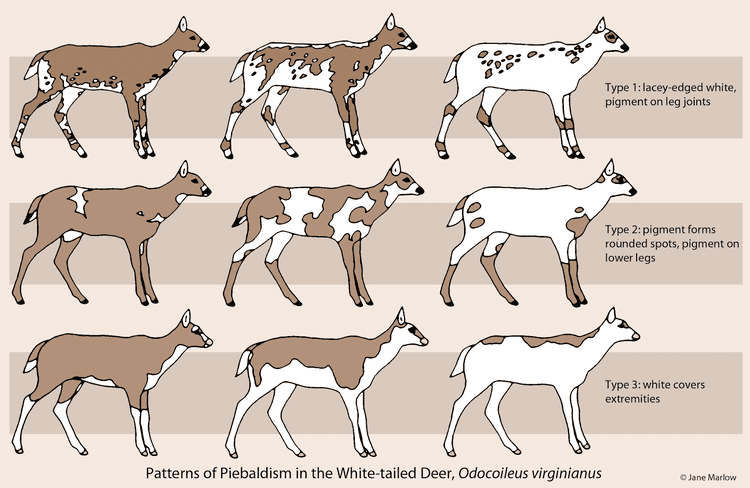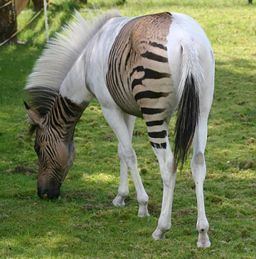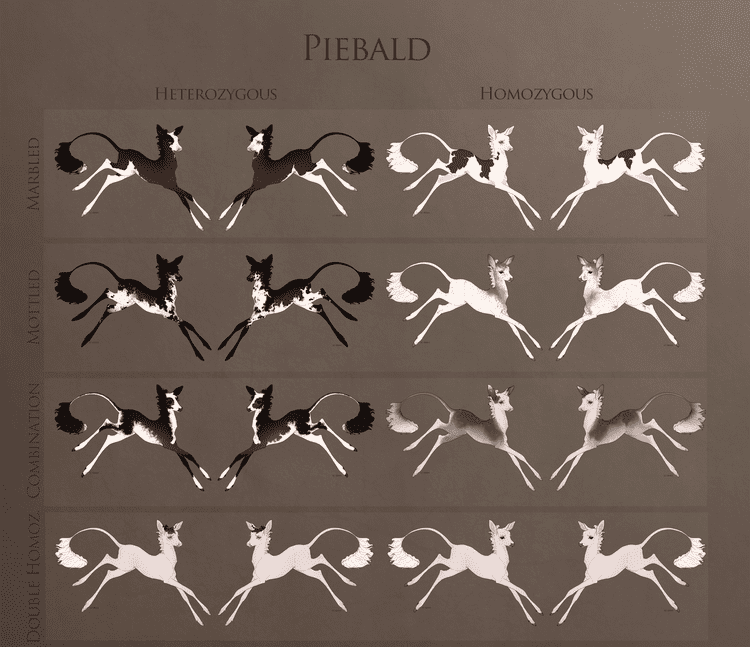 | ||
A piebald or pied animal is one that has a pattern of pigmented spots on an unpigmented (white) background of hair, feathers or scales. The spots are pigmented in shades of black and/or yellow as determined by the genotype controlling the color of the animal. The animal's skin underneath its coat may or may not be pigmented under the spots but the skin in the white background is not pigmented.
Contents

Location of the pigmented spots is dependent on the migration of melanoblasts (primordial pigment cells) from the neural crest to paired bilateral locations in the skin of the early embryo. The resulting pattern appears symmetrical only if melanoblasts migrate to both locations of a pair and proliferate to the same degree in both locations. The appearance of symmetry can be obliterated if the proliferation of the melanocytes (pigment cells) within the developing spots is so great that the sizes of the spots increase to the point that some of the spots merge, leaving only small areas of the white background among the spots and at the tips of the extremities.

Animals with this pattern may include horses, dogs, birds, cats, pigs, and cattle, as well as snakes such as the ball python. Some animals also exhibit colouration of the irises of the eye that match the surrounding skin (blue eyes for pink skin, brown for dark). The underlying genetic cause is related to a condition known as leucism.

In medieval English 'pied' indicated alternating contrasting colours making up the quarters of an item of costume or livery device in heraldry. Court jesters and minstrels are sometimes depicted in pied costume and this is the origin of the name of the Pied Piper of Hamelin.
Piebald king of the road
Etymology
The word "piebald" originates from a combination of "pie," from "magpie," and "bald", meaning "white patch" or spot. The reference is to the distinctive black-and white plumage of the magpie.
Horses
In British English piebald (black and white) and skewbald (white and any colour other than black) are together known as coloured. In North American English, the term for this colouring pattern is pinto, with the specialized term "paint" referring specifically to a breed of horse with American Quarter Horse or Thoroughbred bloodlines in addition to being spotted, whereas pinto refers to a spotted horse of any breed. In American usage, horse enthusiasts usually do not use the term "piebald," but rather describe the colour shade of a pinto literally with terms such as "black and white" for a piebald, "brown and white," or "bay and white," for skewbalds, or color-specific modifiers such as "bay pinto", "sorrel pinto," "buckskin pinto," and such.
Genetically, a piebald horse begins with a black base coat colour, and then the horse also has an allele for one of three basic spotting patterns overlaying the base colour. The most common coloured spotting pattern is called tobiano, and is a dominant gene. Tobiano creates spots that are large and rounded, usually with a somewhat vertical orientation, with white that usually crosses the back of the horse, white on the legs, with the head mostly dark. Three less common spotting genes are the sabino, frame and splash overo genes, which create various patterns that are mostly dark, with jagged spotting, often with a horizontal orientation, white on the head. The frame variant has dark or minimally marked legs. The sabino pattern can be very minimal, usually adding white that runs up the legs onto the belly or flanks, with "lacy" or roaning at the edge of the white, plus white on the head that either extends past the eye, over the chin, or both. The genetics of overo and sabino are not yet fully understood, but they can appear in the offspring of two solid-coloured parents, whereas a tobiano must always have at least one tobiano parent.
Other animals
The various types of magpie gave their name to pied coloration. The bald eagle derives its name from the word "piebald" in reference to the contrast of its white head and tail with dark body. The term was used in The Conservationist by Nadine Gordimer when referring to kingfishers.
Many other animal species may also be "pied" or piebald including, but not limited to, squirrels and birds. Snakes, especially ball pythons and corn snakes, may also exhibit seemingly varying patches of completely pigmentless scales along with patches of pigmented scales. Some domesticated foxes born from the Russian Institute of Cytology and Genetics also carry this coloring. Recently, a piebald blood python was discovered in Sumatra.
Bicolor cats carry the piebald gene. The same pattern that applies to cats also applies to dogs when the white spotting gene involved is indeed piebald and not another white-causing gene found in dogs. The piebald gene is also found in domestic guinea pigs, goldfish, rabbits, hamsters, goats, fancy rats, cows, and ferrets.
Dogs, in breeds that may have a spotted or multicolored coat (such as Great Danes), are often called piebald if their body is entirely white or other solid color with spotting and color patches on the head and neck.
